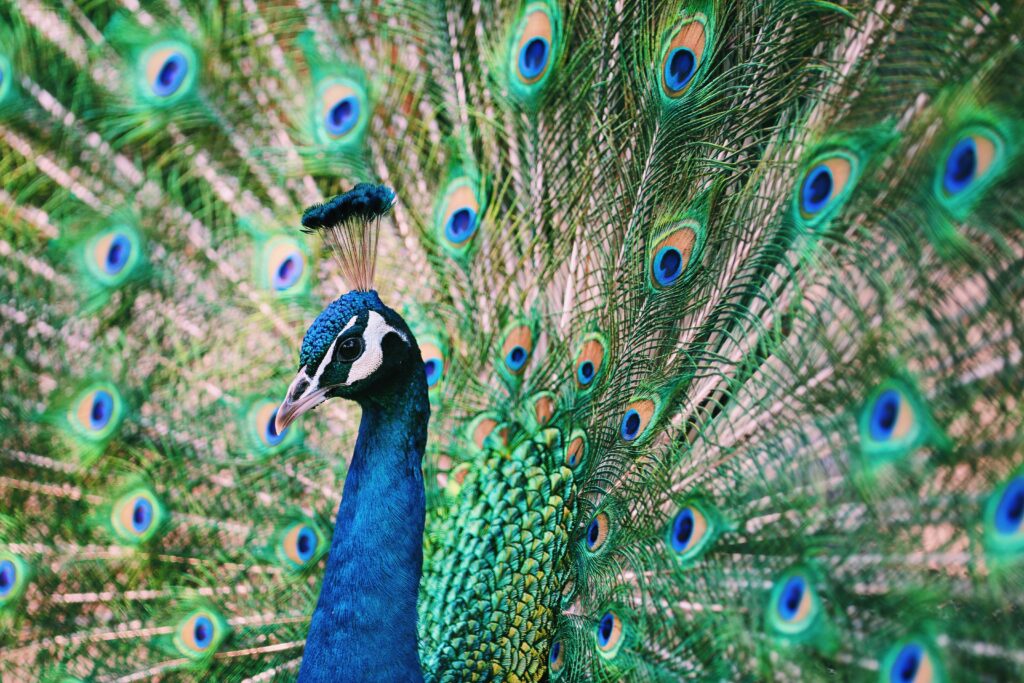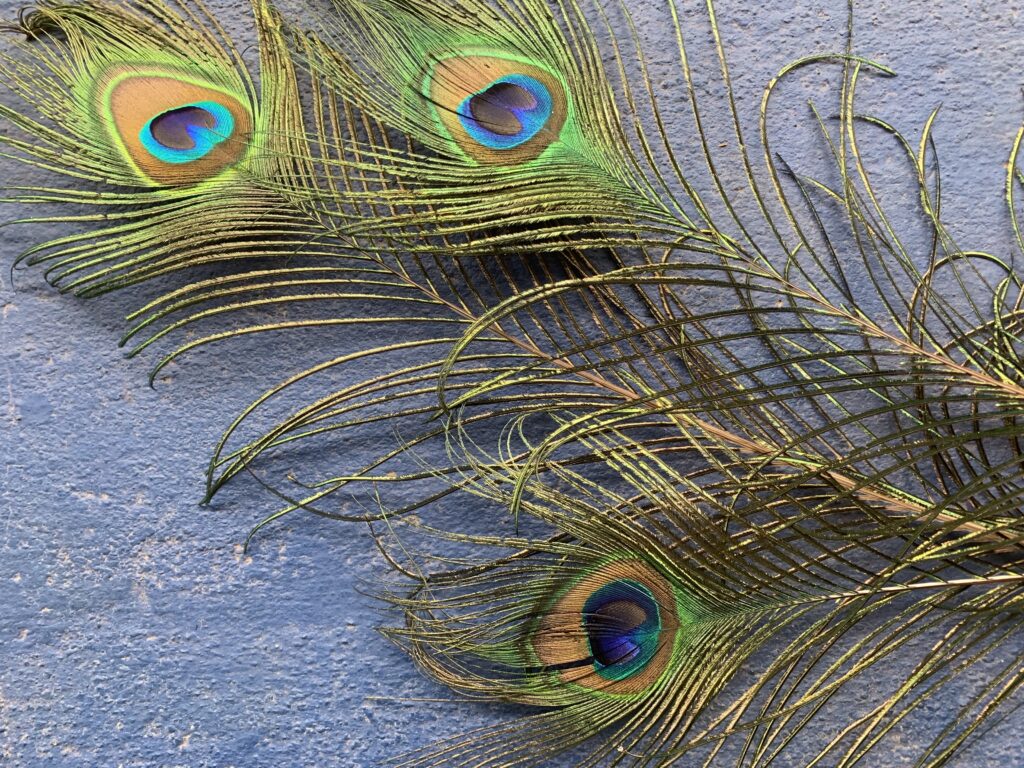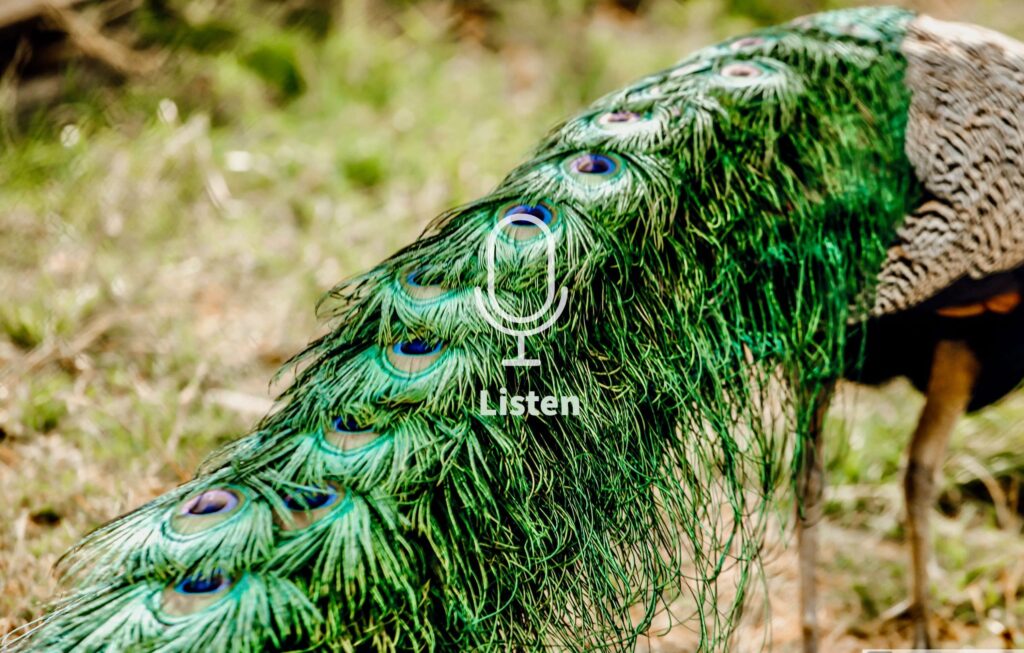Photo courtesy: Og Mpango from Pexels
TRANSCRIPT
Long Long ago, little children, especially little girls collected feathers in Bangalore city. Someone knew of this `below-8-years-trade-among little girls’ and probably even dyed chicken feathers and any white feather into seductive colors, sold them somewhere far away, and by the time it came to us little girls, it felt like such feathers have always been in circulation to skillfully negotiate and procure from within your clique.
Some feathers kept the math homework books warm, some the handwriting homework notebook, as if notebooks were created only to press flower petals, house feathers, and much later into childhood, pass on love letters. Interesting home-works indeed!
Coming back to feathers, there was one that was so premium, that the owner of it evoked envy. If you were that little girl in a Bangalore school, you won’t take long to guess – yes, it was the peacock feather. The jackpot of feather collection.
Friends of my father, who visited the Lord Murugan temple that housed two peacocks within the premise (peacock is considered to be the vehicle, or `vahana’ of this Hindu God), gathered a feather, and brought it for me. Ah…that pleasure in twirling the feather as the proud owner! I remember being totally amazed by how its colours changed even as I twirled it.‘It’s sort of like a double colour’, said the adults. To me it was magic, like my mum’s Kanchivaram silk sari. Different colours as she wore it and walked around. Also that eye in the feather looking back at me. Do they have their eyes in the feathers? There are so many questions at that age, but often I remember never wishing to ask anyone for answers. Maybe not knowing, added to the beauty of wonder and imagination. And so none of this mattered as much as, I now had a peacock feather in my collection!

Photo courtesy: Stone Wang on Unsplash
I am certain that many of you have seen a peacock – either in the wild, or in a zoo, in a movie, and if not, at least in a picture. I am also sure if there is one thing that struck you, it is the brilliant, iridescent colours in that long train of feathers along the tail, especially that of the male peacock. It can reach up to six feet long, and makes up for 60% of the body length.
So imagine, many, many, many years later, in my Biomimicry studies, I learnt something totally `cool’ about these colours! That question I had about the `double colour’ was answered, to further blow my mind away.
What if I told you that these colours do not come from pigments present in the cells of their body. In other words, what if I told you that they are not chemically produced colours at all.
The only colour pigment present in a peacock’s feather, melanin, gives out the dark brown colour. However, it is the nano or microscopic structures on their feathers that disperse or split up the incoming light into different frequencies, displaying a broad array of colours – green-blue-yellow-brown, depending on the angle from which we view it. More than just the `double colour’!
Let me explain this further. Colours in living things are formed in two ways. One is through pigments which are chemicals in the body with specific colours. The other way colour is made is through nanostructures or microscopic structures, which selectively reflect light.
Which means that in several birds and insects, colour comes from structural components. The interaction between light and these submicron structures result in those iridescent colours that we see.
What does iridescent mean? It is a lustrous rainbowlike play of colour caused by differentialrefraction of light waves, that tends to change as the angle of view changes (ref, Merriam-Webster)…like the colours we see through in soap bubbles, or sometimes CDs/DVDs when it catches light.
It is this iridescence that mesmerizes us when we see it on certain life forms. The peacock’s tail feather contain 2D photonic-crystal structures that are either oval shaped or circle shaped. It is the arrangement of these structures in two ways, thickness or layering and the other the spacing or orientation, that leads to the reflection of light waves causing the diversified colours, depending on the angle you are seeing it from.
If you wish to understand this visually, I have created a small video explaining it, and I do encourage you to watch it.
Video Shoot: Parwati Budha
Visuals inspired by a combination of resources in the reference section
This incredible strategy in nature to use structure and not chemicals to meet a function, which in this case, is to produce colours, is a highly recurring pattern in several organisms in Nature, clearly indicating it is a successful, time-tested strategy of millions of years.
We see this magnificence of structural colours in hummingbirds where the light splits into such rich frequencies; in several species of butterflies like the Morpho butterfly with its stellar blue that is a result of such reflection from the structural patterns in the scales of its wings; in some damselflies; kingfisher; bee-eaters; and many other types of birds and insects. Sometimes structural colour needn’t result in iridescent colours, and can lead to just a blue colour, and it is found that blue colours in feathers are produced in this manner.
Can you now, guess the added benefit of structural colour? Much after the organism has died, its colours live on and never fade away, unlike the pigment-dependent colours.
Just like the dead carpenter bee I picked up from the road a few days ago. What perfect timing to chance upon this lovely creature, so I can show you what I mean. (Please watch the video, to enjoy its magnificence)
Video Shoot: Parwati Budha
Source of information: asknature.org
What an invitation the natural world seems to be making to us, with its simple and beautiful mechanism in producing colours! So – product designers, manufacturers, textile designers, jewellery designers, engineers among us, what do you think? What design ideas is this inspiring in you?
In fact, Qualcomm, a tech company, inspired by the scales of the Morpho butterflies, brought into the market the Mirasol eReader display screen that can be used in smartphones, tablets, e-readers when there is full sunlight, due to the structural makeup of the screen which mimicks the butterfly structures. The CEO has now licensed out this technology for anyone interested. More and more designers are working on mimicking this beautiful strategy, available to us, for free, from the natural world. This is the growing field of Biomimicry applications too
Imagine, if a whole lot of human design challenges that use toxic pigments as solutions, could be substituted with structural colours? It can meet the designers love for aesthetics and colours, without causing the chemical pollution that is an outcome of industry waste.
I wouldn’t mind wearing a dress, or a piece of jewellery that people can admire from different angles. Just like how author, Jenny Orbeck, in her article (I have given the link below) observes in peacocks – she brings to attention, how once the male peacock lifts and fans out its feathers to attract a female, they move back and forth to create a shimmering effect on their colourful feathers. The longer the train, the better the chances of seducing the female.
Soon, it will be the mating season for peacocks in many parts of India, and when we see the male shimmying away, we know how clever he is, using structure to meet a good function.
As for me, I seem to have come a full circle since being that little girl. Today I live in a village called Moira, and one of the story threads on how it got this name says that since this was a settlement of the Mauryan empire, and we all know that the important symbol of this empire was the peacock, and so `Moira’, where the root word `mor’, means peacock, came from there.
But here is the interesting part – I misplaced the peacock feather a dear friend gave me, and so wanted one for writing this post.
Every day, in front of our current home, a family of one male peacock and 3 peahens cross the road in the mornings from the fields into the wild growth of trees to an area behind our home, and return to the fields much later in the day, and so I requested one of our neighbours who is a farmer to help me with a feather in case he can find one in the fields. Two days ago, his family gathered three of them, and brought it to me which is what you see in the picture.

Source of feathers: My dear Moira neighbours
So as I sit down and twirl not one, but three peacock feathers, just like I did as a little girl, the Universe seems to have shimmied me through a long train of seduction with peacocks, so I can connect the many dots, and share this story with you all.
The next time you are on a walk, or a nature hike, or go bird watching or insect watching, and spot such iridescent colours on any of the lovely creatures, do not forget to tell this story. If you still have a peacock feather in one of your notebooks, I invite you to go enjoy it again, and share with me what it felt like this time.
I have also shared a few reference links to articles below, incase you would like to go down the interesting rabbit hole and dig more.
Thank you for reading-listening-watching.
Look forward to hearing all your thoughts.
And, if you enjoyed learning about this, please do share it with friends or loved ones, who might do so as well.
Sources if you wish to further shimmy on:
On Structural Colours: Orbeck JNanostructures in chameleons, damselflies, and peacocks (oh my!) [Internet] [Cited 2021 March]. Available from: http://sustainable-nano.com/2019/08/02/nanostructures-in-chameleons-damselflies-and-peacocks-oh-my.
On birds and colourful feathers: How Birds Make Colorful Feathers [Internet] [Cited 2021 March]. Available from: https://academy.allaboutbirds.org/how-birds-make-colorful-feathers/
On Morpho Butterfly inspiring Mirasol Technology: McKeag T, Zygote Quarterly Spring 2013: Requiem for a Butterfly: Mirasol’s Market Meltdown [Cited 2019 November]


Suchitra H K
Such an important learning, thank you Anjan! It’s so amazing to know about structural colors..
This article also brought back childhood memories of trading colorful feathers and indeed peacock feather was a mega bonus ?
Keep sharing! Would love to visit the peacock’s family some day.
Anjan Prakash
Thanks Suchi – so happy that it brought back memories. Yes, you have to enjoy the peacock family. 🙂
Nanditha Lakshman
I learned something new today! I had no idea about 2D photonic-crystal structures .
I still have the peacock feather my cousin gave me when I was 7 yrs old, it was my priceless possession as a kid 🙂 Thanks for sharing .
Anjan Prakash
Hey dearest N – How lovely that you still have the peacock feather :). How much we all loved getting it right?
Thanks for sharing.
Neha
Hi anjan
Lovely post. Enjoyed learning about iridescent colours and nano structures. Thanks for making the effort at simplifying and explaining the science through videos.
Best wishes
Anjan Prakash
Thank you Neha. Glad the science was accessible. Thank you for listening and writing in. ?
Sneha Iype
Lovely. Informative and very well written. Thank you.
Anjan Prakash
Thanks dear Sneha. Thanks for listening/watching and for writing. Hugg.?